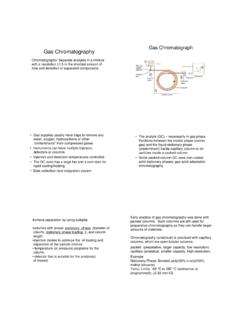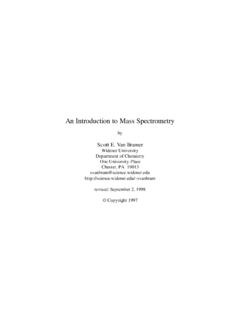Transcription of METHYLENE CHLORIDE 1005 - cdc.gov
1 METHYLENE CHLORIDE 1005. CH2Cl2 MW: CAS: 75-09-2 RTECS: PA8050000. METHOD: 1005, Issue 3 EVALUATION: FULL Issue 1: 15 August 1984. Issue 3: 15 January 1998. OSHA : 25 ppm; STEL 125 ppm PROPERTIES: liquids, d g/mL @ 20 C; BP 40 C;. NIOSH: lowest feasible; carcinogen MP -95 C; VP 47 kPa ( 349 mm Hg) ACGIH: 50 ppm; suspect carcinogen 25 C, nonflammable (1 ppm = mg/m3). SYNONYMS: dichloromethane, METHYLENE dichloride SAMPLING MEASUREMENT. SAMPLER: SOLID SORBENT TECHNIQUE: GAS CHROMATOGRAPHY, FID. (2 coconut shell charcoal tubes, 100/50 mg). ANALYTE: METHYLENE CHLORIDE FLOW RATE: to L/min DESORPTION: 1 mL CS2. VOL-MIN: L @ 500 ppm INJECTION. -MAX: L VOLUME: 1 L. TEMPERATURE-INJECTION: 250 C. SHIPMENT: separate front and back tubes -DETECTOR: 300 C.
2 -COLUMN: 80 to150 C at 10 C/min SAMPLE. STABILITY: ca. 30 days @ 5 C [1] CARRIER GAS: Helium, mL/min BLANKS: 2 to 10 field blanks per set COLUMN: capillary, 30 m x ID, m film polyethylene glycol, Stabilwax, or equivalent CALIBRATION: solutions of METHYLENE CHLORIDE in CS2. ACCURACY. RANGE STUDIED: 1700 to 7097 mg/m3 [2] RANGE: to 2600 g per sample [1]. BIAS: - ESTIMATED LOD: g per sample [1]. OVERALL PRECISION ( rT ): [1, 2]. PRECISION ( r): [1]. ACCURACY: APPLICABILITY: The working range for GC-FID analysis is to 749 ppm ( to 2600 mg/m3) for a 1-L air sample [1]. An electron capture detector (ECD) also may be used to obtain lowest feasible level of detection and quantitation [3]. Conditions for using an ECD.
3 Are listed in the APPENDIX. INTERFERENCES:No specific interferences were identified. However, any compound with a similar retention time may interfere. Alternate chromatographic columns are Carbowax-PEG and DB-1 fused silica capillary columns. The capacity of the charcoal is greatly reduced when sampling in high humidity [4]. OTHER METHODS:This revises NMAM 1005 (dated 8/15/94) [5]. If sampling in an atmosphere with high relative humidity ( 80%), a tube with larger bed of charcoal is recommended. OSHA Method 59 uses a sampler with three sorbent sections, each containing 350. mg of charcoal, and has been evaluated for a 10-L air sample at 1 ppm of METHYLENE CHLORIDE with 80% relative humidity [4]. OSHA Method 80 uses a carbon molecular sieve sampler and GC-FID analysis, and has been evaluated at 10 ppm and 500 ppm [6].
4 NIOSH Manual of Analytical Methods (NMAM), Fourth Edition METHYLENE CHLORIDE : METHOD 1005, Issue 3, dated 15 January 1998 - Page 2 of 4. REAGENTS: EQUIPMENT: 1. METHYLENE CHLORIDE , chromatographic grade.* 1. Sampler: glass tube, 7 cm long, 6-mm OD, 2. Carbon disulfide, chromatographic grade. * 4-mm ID, flame-sealed ends with plastic caps, 3. Helium, purified. containing two sections of activated (600 C. 4. Hydrogen, prepurified. coconut shell charcoal (front = 100 mg, back =. 5. Air, filtered. 50 mg) separated by a 2-mm urethane foam plug. A silylated glass wool plug precedes the front section and a 3-mm urethane plug follows * See SPECIAL PRECAUTIONS the back section. Tubes are commercially available (SKC #226-01, Supelco ORBO-32s, or equivalent).)
5 2. Personal sampling pump, to L/min, with flexible connecting tubing. 3. Gas chromatograph, flame ionization detector, integrator, and column (page 1005-1). 4. Vials, autosampler, with PTFE-lined caps. 5. Microliter syringes, 10- L and other sizes as needed, readable to L. 6. Flasks, volumetric, various sizes. 7. Pipets, various sizes. SPECIAL PRECAUTIONS: Carbon disulfide is toxic and a serious fire and explosion hazard (flash point = -30 C). METHYLENE CHLORIDE is a suspected carcinogen. Wear appropriate protective clothing and work with these compounds in a well ventilated hood. SAMPLING: 1. Calibrate each personal sampling pump with a representative sampler in line. 2. Break ends of sampling tubes immediately before sampling.
6 Attach sampler train to personal sampling pump with flexible tubing. 3. Sample at an accurately known flow rate between and L/min for total a sample size of to L. 4. Separate the front and backup tubes to prevent migration of METHYLENE CHLORIDE between tubes. Cap the samplers and pack securely for shipment. SAMPLE PREPARATION: 5. Place front (along with first glass wool plug) and back sorbent sections of each tube in separate vials. Discard the foam plugs. 6. Add 1 mL of desorption solvent, CS2, to each vial and attach crimp caps. NOTE: Significant heat is generated when the desorbing solution is added to the charcoal. To minimize sample loss, chill the desorbing solution before adding to the charcoal [4].
7 7. Allow to stand 30 min with occasional agitation to aid desorption. CALIBRATION AND QUALITY CONTROL: 8. Calibrate daily with at least six working standards over the range of interest. Three standards (in duplicate) should cover the range from the LOD to LOQ. a. Add known amounts of METHYLENE CHLORIDE to CS 2 in 10-mL volumetric flasks and dilute to the mark. NOTE: An internal standard such as 2-butanol or hexane can be added to the CS 2. NIOSH Manual of Analytical Methods (NMAM), Fourth Edition METHYLENE CHLORIDE : METHOD 1005, Issue 3, dated 15 January 1998 - Page 3 of 4. b. Analyze together with samples and blanks (steps 11 and 12). c. Prepare calibration graph (peak area or height vs. g METHYLENE CHLORIDE ).
8 9. Determine desorption efficiency (DE) at least once for each lot of charcoal tubes used for sampling in the calibration range (step 8). Prepare three samplers at each of 6 levels plus three media blanks. a. Remove and discard back sorbent sections of sampler and media blanks. b. Inject a known amount of methylenechloride directly onto the front sorbent bed of each charcoal tube. c. Allow the tubes to air equilibrate for several minutes, then cap the ends of the tubes and allow to stand overnight. d. Desorb the samples(steps 5 through 7) and analyze together with standards and blanks (steps 11. and 12). e. Prepare a graph of DE vs. g METHYLENE CHLORIDE recovered. 10. Analyze three quality control blind spikes and three analyst spikes to ensure that the calibration graph and DE graphs are in control.
9 MEASUREMENT: 11. Set gas chromatograph according to manufacturer's recommendations and to conditions given on page 1005-1. Inject a 1- L sample aliquot manually using solvent flush technique or with an autosampler. NOTE: If peak area is above the linear range of the working standards, dilute with appropriate solvent, reanalyze and apply the appropriate dilution factor in the calculations. 12. Measure peak areas. CALCULATIONS: 13. Determine the mass, g (corrected for DE), for METHYLENE CHLORIDE found in the sample front (W f) and back (Wb) sorbent sections, and in the average media blank front (B. f) and back (Bb)sorbent sections. NOTE: If Wb > Wf/10, report breakthrough and possible sample loss. 14. Calculate concentration, C, of METHYLENE CHLORIDE in the air volume sampled, V (L): (Wf Wb Bf Bb).
10 C , mg/m 3. V. NOTE: g/mL mg/m3. EVALUATION OF METHOD: The method was originally evaluated for METHYLENE CHLORIDE (Method S329) and validated over the range 1700 to 7100 mg/m3 at 25 C and 763 mm Hg using a 1-L sample [2, 7]. Overall precision (rT) using flame ionization detection was with a recovery of (non-significant bias). The concentration of METHYLENE CHLORIDE was independently verified by calibrated syringe pump. Desorption efficiency was over the range of mg to mg METHYLENE CHLORIDE per sample. Breakthrough (5% on backup section). 3. occurred at min when sampling an atmosphere containing 6726 mg/m METHYLENE CHLORIDE at L/min at 0% RH. The stability of METHYLENE CHLORIDE on charcoal was not determined in the original method development.












